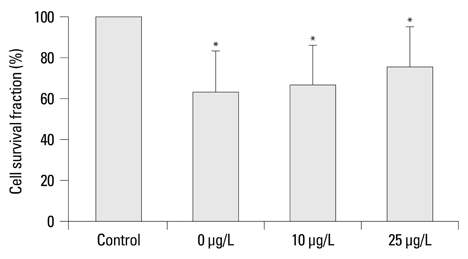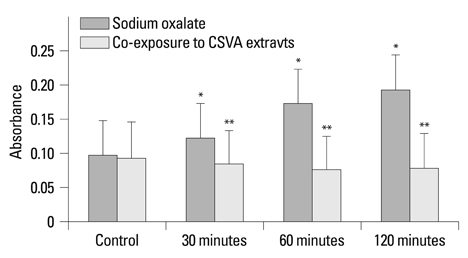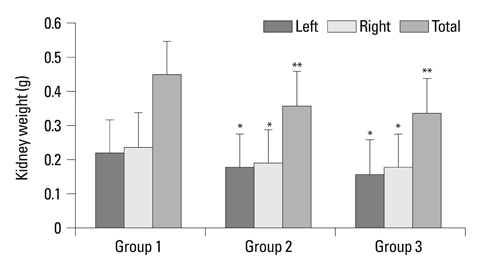Yonsei Med J.
2012 Jan;53(1):138-144. 10.3349/ymj.2012.53.1.138.
Preventive Effects of Green Tea (Camellia Sinensis var. Assamica) on Diabetic Nephropathy
- Affiliations
-
- 1Department of Urology, Seoul National University College of Medicine and Clinical Research Institute, Seoul, Korea. hhkim@snu.ac.kr
- 2Department of Urology, Sungkyunkwan University School of Medicine, Seoul, Korea.
- 3School of Food and Life Science, Inje University, Gimhae, Korea.
- KMID: 1779698
- DOI: http://doi.org/10.3349/ymj.2012.53.1.138
Abstract
- PURPOSE
This study aimed to evaluate the preventive effects of Camellia sinensis var. assamica (CSVA) on diabetic nephropathy in in vitro and in vivo models.
MATERIALS AND METHODS
MDCK cells were incubated with 1 mM of oxalate with or without different concentrations of CSVA, then MTT and malondialdehyde (MDA) assays were performed to investigate the preventive effects of CSVA on oxalate-induced cytotoxicity and oxidative stress. Thirty male db/db mice were divided into three groups. Group 1 were fed AIN-93G ad libitum; group 2 were fed AIN-93G mixed with 10% fermented CSVA ad libitum; group 3 were fed AIN-93G mixed with 10% non-fermented CSVA ad libitum. The mice were sacrificed 14 weeks later, and the serum glucose level, 24-hour urine chemistry, and morphological changes in the kidneys were examined.
RESULTS
As CSVA concentrations increased, viable MDCK cells increased in concentration. MDA production decreased over time in the CSVA treated group. The creatinine clearance of group 3 was lower than those of groups 1 and 2. The amount of urine microalbumin and protein in group 1 were higher than those in groups 2 and 3. Also, more glomerulus basement membrane foot processes were preserved in groups 2 and 3.
CONCLUSION
In conclusion, CSVA has beneficial preventive tendencies towards diabetic nephropathy in both in vitro and in vivo models.
MeSH Terms
Figure
Reference
-
1. Soldatos G, Cooper ME. Diabetic nephropathy: important pathophysiologic mechanisms. Diabetes Res Clin Pract. 2008. 82:Suppl 1. S75–S79.
Article2. Giunti S, Barit D, Cooper ME. Diabetic nephropathy: from mechanisms to rational therapies. Minerva Med. 2006. 97:241–262.3. Renno WM, Abdeen S, Alkhalaf M, Asfar S. Effect of green tea on kidney tubules of diabetic rats. Br J Nutr. 2008. 100:652–659.
Article4. Cabrera C, Artacho R, Giménez R. Beneficial effects of green tea--a review. J Am Coll Nutr. 2006. 25:79–99.
Article5. Crespy V, Williamson G. A review of the health effects of green tea catechins in in vivo animal models. J Nutr. 2004. 134:3431S–3440S.
Article6. Son GM, Bae SM, Chung JY, Shin DJ, Sung TS. Antioxidative Effect on the Green Tea and Pu-erh Tea Extracts. Korean J Food and Nutr. 2005. 18:219–224.7. Thielecke F, Boschmann M. The potential role of green tea catechins in the prevention of the metabolic syndrome - a review. Phytochemistry. 2009. 70:11–24.
Article8. Wong SH, Knight JA, Hopfer SM, Zaharia O, Leach CN Jr, Sunderman FW Jr. Lipoperoxides in plasma as measured by liquid-chromatographic separation of malondialdehyde-thiobarbituric acid adduct. Clin Chem. 1987. 33:214–220.
Article9. Unger J. Diagnosis and management of type 2 diabetes and prediabetes. Prim Care. 2007. 34:731–759.
Article10. The Diabetes Control and Complications Trial Research Group. The effect of intensive treatment of diabetes on the development and progression of long-term complications in insulin-dependent diabetes mellitus. N Engl J Med. 1993. 329:977–986.11. Chang HY, Wallis M, Tiralongo E. Use of complementary and alternative medicine among people living with diabetes: literature review. J Adv Nurs. 2007. 58:307–319.
Article12. Ryu OH, Lee J, Lee KW, Kim HY, Seo JA, Kim SG, et al. Effects of green tea consumption on inflammation, insulin resistance and pulse wave velocity in type 2 diabetes patients. Diabetes Res Clin Pract. 2006. 71:356–358.
Article13. Chan EWC, Lim YY, Chew YL. Antioxidant activity of Camellia sinensis leaves and tea from a lowland plantation in Malaysia. Food Chem. 2007. 102:1214–1222.
Article14. Jeong BC, Kim BS, Kim JI, Kim HH. Effects of green tea on urinary stone formation: an in vivo and in vitro study. J Endourol. 2006. 20:356–361.
Article15. Igarashi K, Honma K, Yoshinari O, Nanjo F, Hara Y. Effects of dietary catechins on glucose tolerance, blood pressure and oxidative status in Goto-Kakizaki rats. J Nutr Sci Vitaminol (Tokyo). 2007. 53:496–500.
Article16. Yamabe N, Yokozawa T, Oya T, Kim M. Therapeutic potential of (-)-epigallocatechin 3-O-gallate on renal damage in diabetic nephropathy model rats. J Pharmacol Exp Ther. 2006. 319:228–236.
Article17. Yokozawa T, Nakagawa T, Oya T, Okubo T, Juneja LR. Green tea polyphenols and dietary fibre protect against kidney damage in rats with diabetic nephropathy. J Pharm Pharmacol. 2005. 57:773–780.
Article18. Christiansen JS, Gammelgaard J, Frandsen M, Parving HH. Increased kidney size, glomerular filtration rate and renal plasma flow in short-term insulin-dependent diabetics. Diabetologia. 1981. 20:451–456.
Article19. Zatz R, Brenner BM. Pathogenesis of diabetic microangiopathy. The hemodynamic view. Am J Med. 1986. 80:443–453.
Article20. Li JJ, Kwak SJ, Jung DS, Kim JJ, Yoo TH, Ryu DR, et al. Podocyte biology in diabetic nephropathy. Kidney Int Suppl. 2007. S36–S42.
Article21. Guo Q, Zhao B, Li M, Shen S, Xin W. Studies on protective mechanisms of four components of green tea polyphenols against lipid peroxidation in synaptosomes. Biochim Biophys Acta. 1996. 1304:210–222.
Article22. Zaveri NT. Green tea and its polyphenolic catechins: medicinal uses in cancer and noncancer applications. Life Sci. 2006. 78:2073–2080.
Article23. Tu YY, Xia HL, Watanabe N. The changes of catechins during the fermentation of green tea. Prikl Biokhim Mikrobiol. 2005. 41:652–655.
- Full Text Links
- Actions
-
Cited
- CITED
-
- Close
- Share
- Similar articles
-
- Transactivation of peroxisome proliferator-activated receptor alpha by green tea extracts
- Anti-melanogenic effects of black, green, and white tea extracts on immortalized melanocytes
- The effects of green tea (Camellia sinensis) flower extracton melanin synthesis in B16-F10 melanoma cells
- Effect of Leaf-Extract from Camellia sinensis and Seed-Extract from Casia tora on Viability of Mutans Streptococci isolated from the interface between orthodontic brackets and tooth surfaces
- Association Between Green Tea Consumption and Lung Cancer Risk





